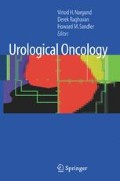Abstract
In vitro cell culture techniques facilitate cultivation of human- and animal-origin cells for prolonged periods of time. Cell lines, harvested from primary or metastatic sites, maintain some of the phenotypical characteristics of the tumor of origin. However, establishing cell lines from early or premalignant disease, such as primary cultures, is more difficult. Cells can be immortalized inadvertently by exposure to environmental carcinogens or by repeated passage, transfection with viral or human oncogenes, and chemical or radiation exposure. Cell lines are vulnerable to significant interspecies and intercell-type contamination.
Access this chapter
Tax calculation will be finalised at checkout
Purchases are for personal use only
Preview
Unable to display preview. Download preview PDF.
References
Navone NM, Logothetis CJ, von Eschenbach AC, Troncoso P. Model systems of prostate cancer: uses and limitations. Cancer Metastasis Rev 1998;17:361–371.
Dinney CP, McConkey DJ, Millikan RE, et al. Focus on bladder cancer. Cancer Cell 2004;6:111–116.
Brandau S, Böhle A. Review of bladder cancer: I. Molecular and genetic basis of carcinogenesis. Eur Urol 2001;39:491–497.
Hillman GG, Droz JP, Haas GP. Experimental animal models for the study of therapeutic approaches in renal cell carcinoma. In Vivo 1994;8:77–80.
Yeung RS, Xiao GH, Jin G, et al. Predisposition to renal carcinoma in the Eker rat is determined by germ-line mutation of the tuberous sclerosis 2 (TSC2) gene. Proc Natl Acad Sci USA 1994;91:11413–11416.
Okimoto K, Sakurai J, Kobayashi T, et al. A germ-line insertion in the Birt-Hogg-Dube (BHD) gene gives rise to the Nihon rat model of inherited renal cancer. Proc Natl Acad Sci USA 2004;101:2023–2027.
Montironi R, Mazzucchelli R, Scarpelli M. Molecular techniques and prostate cancer diagnostic. Eur Urol 2003;44:390–400.
Petricoin EF, Ornstein DK, Liotta LA. Clinical proteomics: applications for prostate cancer biomarker discovery and detection. Urol Oncol 2004;22:322–328.
Sanchez-Carbayo M. Recent advances in bladder cancer diagnostics. Clin Biochem 2004;37:562–571.
Lin X, Tascilar M, Lee W-H, et al. GSTP1 CpG island hypermethylation is responsible for the absence of GSTP1 expression in human prostate cancer cells. Am J Pathol 2001;159:1815–1826.
Sarosdy MF, Schellhammer P, Bokinsky G, et al. Clinical evaluation of a multi-target fluorescent in situ hybridization assay for detection of bladder cancer. J Urol 2002; 168:1950–1954.
Lemoine NR, ed. Understanding Gene Therapy, 1st ed. Oxford: Bios, 1999.
Foley R, Lawler M, Hollywood D. Gene-based therapy in prostate cancer. Lancet Oncol 2004;5:469–479.
Mazhar D, Waxman J. Gene therapy for prostate cancer. BJU Int 2004;93:465–469.
Pagliaro LC. Gene therapy for bladder cancer. World J Urol 2000;18:148–151.
Gore M, Riches P, eds. Immunotherapy in Cancer, 1st ed. Chichester: Wiley, 1996.
Fuchs EJ, Matzinger P. Is cancer dangerous to the immune system? Semin Immunol 1996;8:271–280.
Igney FH, Krammer PH. Immune escape of tumors: apoptosis resistance and tumor counterattack. J Leukoc Biol 2002;71:907–920.
Bohle A, Brandau S. Immune mechanisms in bacillus Calmette-Guerin immunotherapy for superficial bladder cancer. J Urol 2003:170:964–969.
Mancuso A, Sternberg CN. What’s new in the treatment of metastatic kidney cancer? BJUInt 2005;95:1171–1180.
Shiraishi T, Muneyuki T, Fukutome K, et al. Mutations of ras genes are relatively frequent in Japanese prostate cancers: pointing to genetic differences between populations. Anticancer Res 1998;18:2789–2792.
Giovannucci E. The epidemiology of vitamin D and cancer incidence and mortality: a review (United States). Cancer Causes Control 2005;16:83–95.
John EM, Schwartz GG, Koo J, Van Den Berg D, Ingles SA. Sun exposure, vitamin D receptor gene polymorphisms, and risk of advanced prostate cancer. Cancer Res 2005;65:5470–5409.
Coetzee GA, Ross RK. Re: prostate cancer and the androgen receptor. J Natl Cancer Inst 1994;86:872–873.
Madeb R, Messing EM. Gender, racial and age differences in bladder cancer incidence and mortality. Urol Oncol 2004;22:86–92.
Anisimov VN. The relationship between aging and carcinogenesis: a critical appraisal. Crit Rev Oncol Hematol 2003;45:277–304.
Balducci L, Ershler WB. Cancer and ageing: a nexus at several levels. Nat Rev Cancer 2005;5:655–662.
Serrano M, Blasco MA. Putting the stress on senescence. Curr Opin Cell Biol 2001; 13:748–753.
Author information
Authors and Affiliations
Editor information
Editors and Affiliations
Rights and permissions
Copyright information
© 2008 Springer-Verlag London Limited
About this chapter
Cite this chapter
Rajan, P., Leung, H.Y. (2008). Animal Models in Genitourinary Malignancies. In: Nargund, V.H., Raghavan, D., Sandler, H.M. (eds) Urological Oncology. Springer, London. https://doi.org/10.1007/978-1-84628-738-1_2
Download citation
DOI: https://doi.org/10.1007/978-1-84628-738-1_2
Publisher Name: Springer, London
Print ISBN: 978-1-84628-387-1
Online ISBN: 978-1-84628-738-1
eBook Packages: MedicineMedicine (R0)

